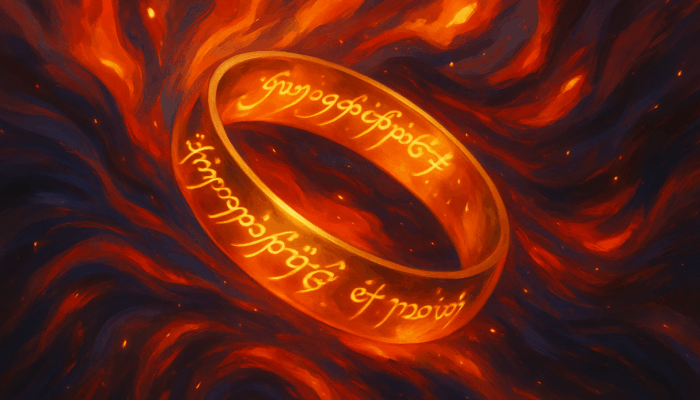
Few fantasy worlds have captured the imagination of readers and viewers like J.R.R. Tolkien’s Middle-earth. Whether you first encountered it through The Lord of the Rings or the sweeping visuals of Peter Jackson’s films, chances are your eyes lingered on the same thing geologists can’t help obsessing over: the mountains. Towering, treacherous, mysterious — the Misty Mountains, the White Mountains, the jagged black spine of Mordor. While most see them as mere fantasy scenery, some of us can’t help but ask: how did these mountains really form?
Today we explore Tolkien’s mountain belts through the lens of geodynamics. No spells, no Morgoth — just tectonics, magmatism, and a whole lot of uplift and erosion. The result is something Tolkien may never have intended, but undoubtedly inspired: a coherent, if speculative, geological history of Middle-earth.
A Pre-Tectonic Map with a Tectonic Soul
Maps of Middle-earth often resemble medieval or Renaissance cartography more than modern topographic or geological charts. Their angular shapes, linear mountain chains, and constrained coastlines echo a time when Earth’s surface was imagined as a static patchwork of realms rather than a dynamic crust shaped by drifting plates. This makes sense: Tolkien was writing decades before the widespread acceptance of plate tectonics. Alfred Wegener’s theory of continental drift (1912) remained controversial during his lifetime, and it was only in the late 1960s — through the work of Vine, Matthews, Hess, and others — that plate tectonics became the unifying framework of geology.

Map of Middle-earth, showing major mountain ranges, realms, and coastlines as depicted in J.R.R. Tolkien’s legendarium. Adapted from the original map by Christopher Tolkien.
Setting the Stage: A Continent with Plate Tectonics?
Tolkien’s Middle-earth is not bound by scientific laws, but it possesses structure, history, and landform patterns that mirror our own planet. It has ocean margins, volcanic provinces, sedimentary basins, mountain ranges, and even evidence of deep geological time. He aimed to create a “mythology for England”, but in the process sketched a working proto-continent.
Although Middle-earth does not explicitly follow real-world plate tectonics, applying geodynamic reasoning to its landscapes is surprisingly rewarding. Some fans place it in a post-Pangaea Earth; others imagine a parallel world with its own mantle convection and plate boundaries. Either way, the premise works — and once accepted, the tectonic possibilities become irresistible.
The Misty Mountains: An Orogenic Spine
The Misty Mountains — home to dwarves, goblins, eagles, and at least one Balrog — stretch north–south for hundreds of kilometres, forming a formidable east–west barrier. Tolkien tells us they were raised in the First Age as a defensive wall, but stripped of mythology, they look like a classic continent–continent collision zone, akin to the Himalayas or Alps. We have some clues supporting this view:
- Linear, elongated structure: Consistent with a suture zone formed during collision.
- High, rugged topography: Suggesting a geologically young orogen, with crustal thickening still resisting erosion.
- Mineral-rich zones: Mithril’s exclusivity to this range hints at hydrothermal activity linked to magmatism.
- Subsurface magmatism: The Balrog’s fiery domain beneath Moria could represent post-orogenic magmatism or partial crustal melting.
In tectonic terms, the Misty Mountains might be an continent–continent collision belt, incorporating accreted terranes, metamorphic nappes, and deep crustal roots.
Mordor and Mount Doom: A Volcanic Arc in Extension?
Geologically speaking, Mordor is one of the most obvious features in Middle-earth. Enclosed by mountains on three sides and dominated by Mount Doom, it is a natural volcanic focus. Orodruin (Mount Doom) is a textbook stratovolcano: persistent activity, a central vent, and a magma chamber capable of melting “the One Ring”. This leads us to a few possible settings:
- Subduction-related volcanic arc, with Mount Doom above a descending slab.
- Continental rift zone, where lithospheric thinning feeds volcanism within a graben-like depression.
- Caldera system reawakened after partial collapse.
Persistent volcanism points to high mantle heat flow, whether from subduction or a plume source. Mordor could thus be viewed as a structurally enclosed basin with an active magmatic system — geologically unstable and strategically defensible.
The White Mountains: Ancient Roots, Briefly Awakened
South of Rohan and Gondor rise the White Mountains — lower, broader, and more eroded than the Misty Mountains. They resemble an older orogen, akin to the Variscan belt in Europe or the Appalachians in North America. The key evidence for their antiquity can be:
- Karst features: The Paths of the Dead may traverse extensive limestone cave systems.
- High plateaus and relict peaks: Hallmarks of a once-towering range subdued by erosion.
- Possible reactivation: Localised uplift around Helm’s Deep may coincide with structural intersections.
These mountains likely represent the exhumed roots of a long-dead collision zone, rejuvenated only by later tectonic pulses.
Mithril, Magic, and Hydrothermal Systems
Mithril — silvery, light, stronger than steel — is mined only in the Misty Mountains beneath Khazad-dûm. From a geological perspective, such mineralisation would require:
- A magmatic heat source to drive hydrothermal circulation.
- Fractured host rocks to allow fluid migration.
- Pressure–temperature changes to precipitate the ore.
Mithril may be an imaginative fusion of silver, titanium, and rare-earth metals, formed in epithermal or porphyry-style deposits. The Balrog might be a symbolic warning against mining in geologically unstable terrain.
Landscapes in Deep Time
Tolkien’s world conveys a rare sense of geological time. Landscapes change — rivers shift, cities decay, mountains erode. From a geomorphological standpoint:
- The Misty Mountains are young and actively eroding.
- Mordor is volcanically active and morphologically unstable.
- The White Mountains are ancient, their sediments feeding distant coasts.
Middle-earth is not a static fantasy map; it is a dynamic, evolving land and world.
Fantasy Rooted in Tectonic Logic
Tolkien may not have aimed for geological accuracy, but the coherence of his landscapes is no accident. His writing reflects a deep, almost instinctive understanding of how natural features fit together. Mountains in Middle-earth are not arbitrary backdrops; they have histories. Rivers have sources, valleys have orientations, and volcanic provinces are placed where tectonics would put them. Even without the modern plate tectonic framework, Tolkien captured something essential: the logic of landscapes.
Looking at Middle-earth through a geodynamic lens is more than an exercise in playful speculation — it’s a way to appreciate how much of our planet’s beauty and diversity comes from deep Earth processes. The same tectonic principles that build the Himalayas or the Andes could, in theory, have raised the Misty Mountains. The same volcanic plumbing that fuels Mount Etna or Fuji could be imagined beneath Mount Doom. And the slow erosion that reduces once-mighty ranges to subdued hills could just as well be at work in the White Mountains.
There’s also an anthropological echo here: human cultures have always explained landscapes through myth. From the Norse frost giants carving out fjords, to Māori stories of volcanoes as warring lovers, to Native American legends of mountains that walked, people have long blended storytelling with observations of the natural world. Tolkien’s legendarium is a modern continuation of this tradition — an invented mythology that, intentionally or not, mirrors the structural and geomorphic patterns we recognise as scientists.
Importantly, grounding fantasy worlds in real processes doesn’t diminish their magic. In fact, it can make them more compelling. Knowing that the linear form of the Misty Mountains matches the structural grain of real collisional belts, or that Mordor’s topographic enclosure resembles caldera systems, deepens our immersion. We believe in these places because they follow rules — even if those rules are hidden beneath layers of myth.
This also works in reverse: fantasy can feed back into scientific thinking. Imagining how a world like Middle-earth might evolve geologically forces us to think holistically — about tectonics, climate, erosion, volcanism, and resources as an interconnected system. In doing so, we sharpen our ability to interpret our own planet’s past and present.
Middle-earth’s geology even invites speculative “future history”. What happens when the Misty Mountains have been eroding for tens of millions more years? Will their high peaks collapse into broad plateaus like the Appalachians? Could Mordor’s volcanism eventually wane, leaving behind a great volcanic highland now deeply dissected by rivers? Will the White Mountains vanish entirely, leaving only isolated erosional remnants on a coastal plain? These are the same kinds of questions we ask about Earth’s geological future (or at least me).
In the end, perhaps the real magic is that Middle-earth does not defy nature — it quietly respects it. Or perhaps… Sauron was a geologist.
References Peters, J. (2017) ‘In Defense of Tolkien’s Mountains’, News and Times, 11 August. Available at: https://www.newsandtimes.com/2017/08/in-defense-of-tolkiens-mountains/ (Accessed: 30 June 2025). News and Times Mapsburgh (2017) ‘In Defense of Tolkien’s Mountains’, Mapsburgh (Tumblr), 2 August. Available at: https://mapsburgh.tumblr.com/post/163719865416/in-defense-of-tolkiens-mountains (Accessed: 20 July 2025). Tumblr Gibson, H. (2023) ‘Far over the Misty Mountains cold, to dungeons deep and caverns old: the geology of the Lord of the Rings’, GeoLog (EGU Blogs), 29 September. Available at: https://blogs.egu.eu/geolog/2023/09/29/far-over-the-misty-mountains-cold-to-dungeons-deep-and-caverns-old-the-geology-of-the-lord-of-the-rings/ (Accessed: 4 August 2025). Wegener, A. (1915) Die Entstehung der Kontinente und Ozeane. Braunschweig: Vieweg. [English translation: The Origin of Continents and Oceans, 1924, London: Methuen.]

Frank Zwaan
For further reading on the history, geography and geology of Tolkien’s Middle Earth, I strongly recommend the “Atlas of Middle Earth” by Karen Wynn Fonstad, which has some fantastic (pun intended) illustrations 🙂
https://en.wikipedia.org/wiki/The_Atlas_of_Middle-earth